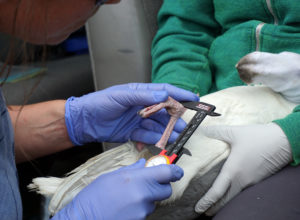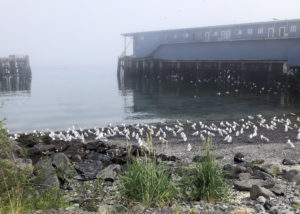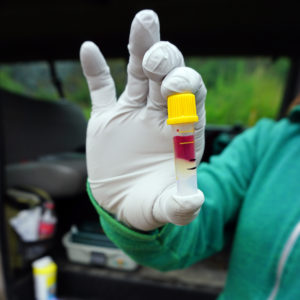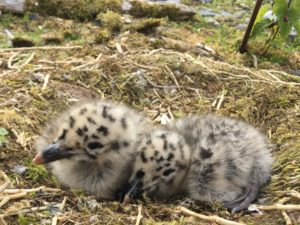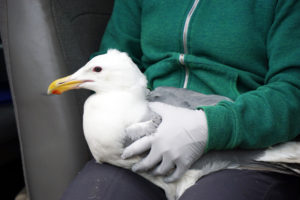Glaucous-winged Gulls and Avian Influenza

By Kinsey Justa, July 22, 2019
During the summer months, Cordova’s seasonal population grows significantly and not just with people. Each year an influx of Glaucous-winged Gulls (Larus glaucescens) can be observed crowding rooftops and docks all around the small coastal town. The seafood industry is the largest employer and primary industry that fuels Cordova’s human economy. From May to September the seafood processing facilities along the waterfront process primarily salmon and produce thousands of pounds of fish offal, or organic waste by-products, each day which is ground and released into the ocean in allowable amounts. This voluminous output of nutrients is an easy and plentiful food source for the Glaucous-winged Gulls which migrate to the region at this same time in order to nest on nearby barrier islands on the Copper River Delta.
Researchers at PWSSC hypothesize that this large congregation of gulls is influencing the prevalence, transmission, and evolution of avian influenza (aka “bird flu”) in the gull population. In collaboration with Tufts University, PWSSC principal researcher Mary Anne Bishop has been researching the population abundance of the Glaucous-winged Gull in this region and how it relates to the spread of avian influenza since 2009.
The study has several important implications regarding the effects human activities have on coastal wildlife populations. In many ways the relationship between the gulls and the seafood processing facilities is an excellent example of human-wildlife interaction in this bioregion. Within a larger scope, the study also aims to further understand the role of gull population abundance in transmitting disease between marine and urban environments. As of yet, this particular strain of avian influenza found in the gulls is not transmittable to humans. However, better understanding the spread of this virus within the gull population may offer a window into understanding how viruses spread and change in human populations as well.
The methods used by PWSSC researchers and staff include banding and tracking the gull’s migration, visual abundance surveys, as well as sampling of the birds’ feces, blood, and saliva for traces of avian influenza. In the field, researchers swab fecal samples on the docks from April through September and often obtain 100 samples per week.
The fecal samples from around town provide researchers with an idea of how prevalent avian influenza is in the gull population over the course of the summer. This method of collecting many samples over the course of several months is focused on monitoring temporal patterns of viral prevalence. Visual gull surveys around town every 10 days or so help provide an additional layer of information on how population density and location changes over time.

Before gulls are released, they are banded with both a metal ID band issued by the Bird Banding Lab (USGS), and a plastic colored band unique to this project.
Gull captures during the summer months allow researchers to obtain more in-depth data through blood samples and oral swabs. The process is quick and painless for the birds and allows researchers to conclude whether the gull has carried the virus in the past.
Over three summer seasons, PWSSC staff and collaborators at Tufts University collected samples from recently hatched chicks on Egg Island. Egg Island is a barrier island on the Copper River Delta and is one of the largest breeding colonies of Glaucous-winged Gulls in the Gulf of Alaska. The samples from the chicks showed that few chicks were shedding the influenza virus. This finding suggests that the birds are being exposed to the virus after departing their nesting areas in the late summer. This observation is consistent with the hypothesis that infected gulls are spreading the virus when they congregate in town for feeding and mingle with immuno-naïve gulls in large concentrations.
As the study progresses, researchers hope to understand more of how this virus mutates and spreads in ways that could be beneficial for the field of advancing human health.
For more information on this study and for project updates please visit the Tufts University Gull Watch page.
More background on the funding for this project and a list of contacts for principal researchers can be found on our research project page.
Want to see more photos of Glaucous-winged Gulls and the avian influenza study? Follow along with our research projects in the #WorldsRichestWaters on our Instagram and Facebook.


